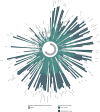Global cervical cancer elimination: quantifying the status, progress, and gaps
- PMID: 39901174
- PMCID: PMC11792702
- DOI: 10.1186/s12916-025-03897-3
Global cervical cancer elimination: quantifying the status, progress, and gaps
Abstract
Background: To address the public health concern of cervical cancer (CC), 194 countries committed to eliminate it at the initiative of the World Health Organization (WHO). We summarised quantitative results concerning CC elimination across these countries, including the progress in implementing three prevention levels (human papillomavirus [HPV] vaccination, CC screening, and treatment for patients with CC) and achievement of interim Global Strategy for Cervical Cancer Elimination targets.
Methods: Data were obtained from the International Agency for Research on Cancer, WHO, United Nations International Children's Emergency Fund, and country responses to the WHO National Capacity Survey on Non-Communicable Diseases. This retrospective analysis examined data from 194 countries and regions, stratified by national income (high-income countries (HICs) vs low- and middle-income countries (LMICs)) and geographic location (continents such as Europe, Asia, and North America). A quantitative assessment evaluated global progress in primary, secondary, and tertiary CC prevention.
Results: By 2020, four countries had achieved Target 1 (90% of girls fully vaccinated against HPV by age 15). A total of 115 countries (51 (44.35%) HICs and 64 (55.65%) LMICs)) included HPV vaccination in their national immunisation programs. As of 2021, 133 countries (50 (37.59%) HICs and 83 (62.41%) LMICs)) implemented CC screening programs. Most of these were in Europe (41, 30.83%), Asia (32, 24.06%), and North America (20, 15.04%). Additionally, 126 countries (44 (34.92%) HICs and 82 (65.08%) LMICs)) had published national guidelines on CC management. These countries were primarily in Asia (32, 25.40%) and Europe (32, 25.40%). Furthermore, 69 countries provided palliative care under both scenarios. The 10 countries with the highest annual opioid consumption (excluding methadone) for CC, in oral morphine equivalence per capita (2017), were all HICs.
Conclusions: Major inequalities persist in CC vaccination and screening across 194 countries, and access to these services is limited in most LMICs. Focusing on vulnerable populations with lower incomes and regions with stunted economic growth may help alleviate inequity and accelerate CC elimination. We also found that tertiary prevention was achieved in most LMICs, but the indicator-reported annual opioid consumption in oral morphine equivalents indirectly illustrates the under-utilisation of cancer treatment services.
Keywords: Cervical cancer elimination; Immunization; Screening; Treatment.
© 2025. The Author(s).
Conflict of interest statement
Declarations. Ethics approval and consent to participate: Not applicable. Consent for publication: Not applicable. Competing interests: The authors declare no competing interests.
Figures




References
-
- Bray F, Laversanne M, Sung H, et al. Global cancer statistics 2022: GLOBOCAN estimates of incidence and mortality worldwide for 36 cancers in 185 countries. CA Cancer J Clin. 2024;74:229–63. 10.3322/caac.21834. - PubMed
-
- Human papillomavirus and cancer. n.d. https://www.who.int/news-room/fact-sheets/detail/human-papilloma-virus-a.... Accessed 6 Feb 2024.
-
- Begum H, Hossain MA, Paul SK, et al. Detection of human papilloma virus by molecular method from patients attending at Colposcopy Clinic of Mymensingh Medical College Hospital, Mymensingh. Mymensingh Med J. 2017;26:600–7. - PubMed
-
- Cervical cancer elimination initiative. n.d. https://www.who.int/initiatives/cervical-cancer-elimination-initiative. Accessed 10 Jan 2025.
MeSH terms
Substances
LinkOut - more resources
Full Text Sources
Medical
Research Materials

